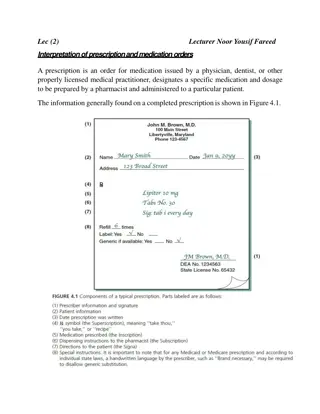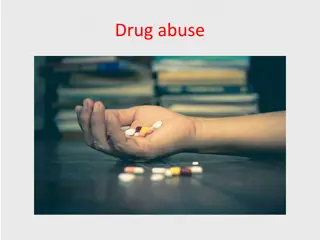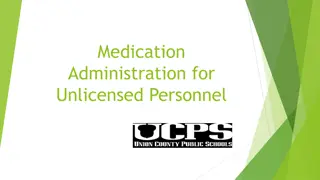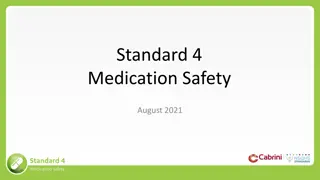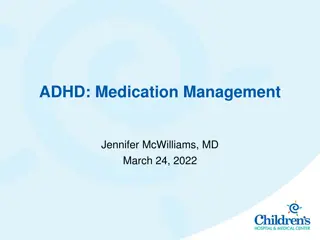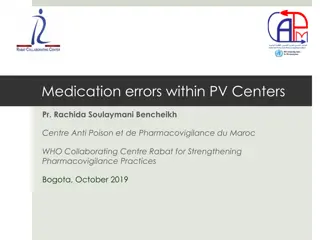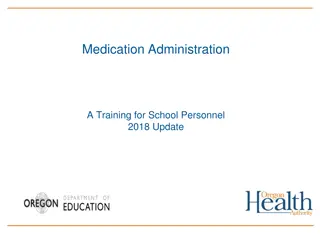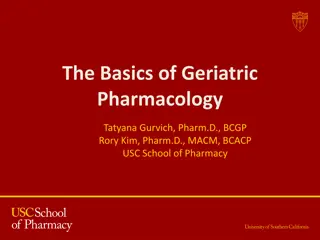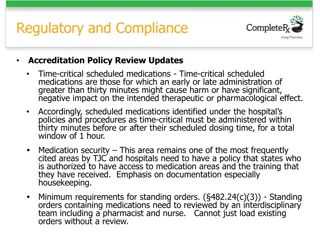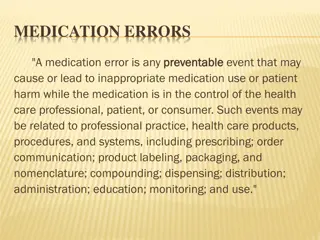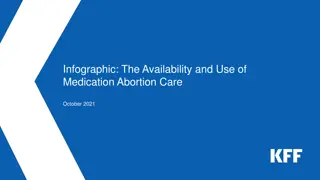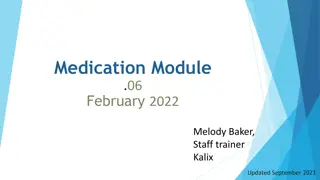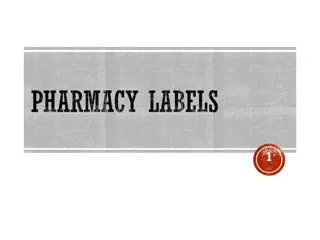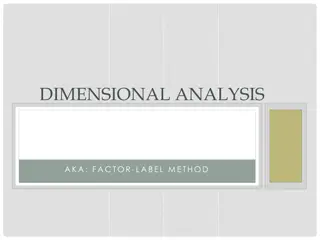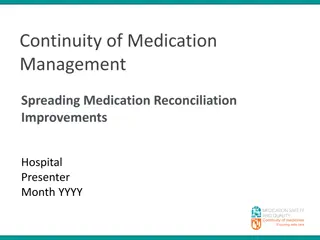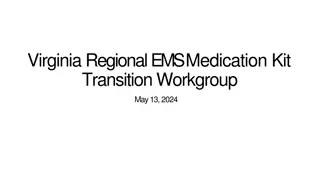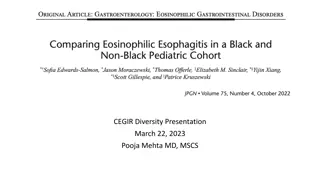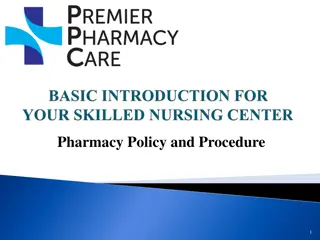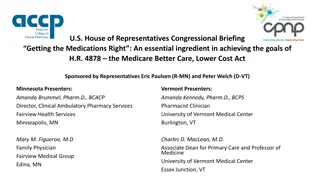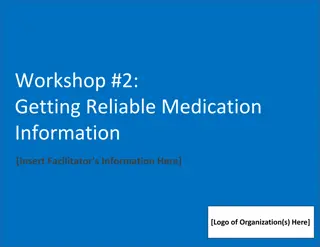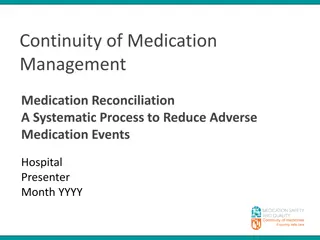Supporting Medication Administration in Social Care Settings
Explore the importance of medication administration in social care settings, emphasizing techniques for safely giving various types of medications. Understand medication instructions, care planning, and recording procedures. Learn about the risks of verbal messages for medication changes and the importance of proper preparation for administering medications.
Download Presentation

Please find below an Image/Link to download the presentation.
The content on the website is provided AS IS for your information and personal use only. It may not be sold, licensed, or shared on other websites without obtaining consent from the author.If you encounter any issues during the download, it is possible that the publisher has removed the file from their server.
You are allowed to download the files provided on this website for personal or commercial use, subject to the condition that they are used lawfully. All files are the property of their respective owners.
The content on the website is provided AS IS for your information and personal use only. It may not be sold, licensed, or shared on other websites without obtaining consent from the author.
E N D
Presentation Transcript
HSC 3047 :Part 2 Support the use of medication in social care settings: Medication administration Sheena Helyer 12.2012
Medication delivery: learning outcomes To understand techniques for administering medication To be able to give the following safely:- Tablets Eye Drops Nasal medication Ear Drops Oxygen Inhaled medication Nebulised medication Medication patches Creams To be aware of devices which can be used to help people take their medicines independently HSC 3047 Medication delivery
Medication instructions When a pharmacist dispenses medication against a valid prescription it must be clearly labelledwith:- The dispensing date The name of the medicine The dose and frequency The route The service user s full name and date of birth Special instructions Warnings or cautions Name of pharmacy Use by date Instructions i.e. Keep out of reach of children HSC 3047 Medication delivery
Care plan and recording Care staff should always read the care plan before giving medicine and check exactly what support is required. There should be a record of what medication should be given and where to find it e.g. in the fridge .This will need to be written out once a month and double checked. The care plan will indicate the level of administration e.g. prompting or administering on behalf of the service user. The carer should sign the record sheet once he/she is sure that the medication has been swallowed or delivered. Any medicine which cannot be given must also be recorded and the reason documented. Any medication not given, gaps on the medication sheet or irregularities must be reported to the manager. HSC 3047 Medication delivery
Verbal messages and changes It can be dangerous to accept instructions by phone Carers must follow their local policy in this situation Usually if there are any changes to the regular medication the dosette box will need to be sent back to the pharmacy for the changes to be made. Warfarin doses may need to be changed following INR blood tests. This is usually organised by the GP and pharmacy. Cumbria.nhs.uk HSC 3047 Medication delivery
Preparation Make sure you have all the necessary equipment ready to give medication. This might include the following:- Tissues Waste bag Tablet cutter or crusher Measuring device Cloth Gloves Glass of water (not hot drink) Pictures provided by weiku.com, colourbox.com mpeb.org HSC 3047 Medication delivery
Principles underpinning medication delivery Infection control Hands should be washed and clean prior to medication administration. Ensure that there are adequate facilities. It is good practice to wear gloves for administration of eye, ear and nasal medication. It is essential to wear gloves when applying medicated cream. Pictures provided by communityservices.heartofengland.nhs.uk HSC 3047 Medication delivery
Principles underpinning medication delivery Dignity and Privacy Staff should always be polite, gentle and respectful of the service user s wishes and choices. Privacy may be needed if there are other occupants in the home and clothing is being removed e.g. applying a patch. HSC 3047 Medication delivery
Principles underpinning medication delivery Correct identification If there is more than one person receiving care their supplies and documentation must be clearly identified and separated. Pictures provided by bbc.co.uk HSC 3047 Medication delivery
Confidentiality Information about a service user s medication is confidential. It should only be shared if permission has been given by the service user or in exceptional circumstances. Protection in law is enshrined in the Human Rights Act 1998, the Data Protection Act 1998 and Common Law. Further guidance has been given in the Health and Social Services and Public Safety Code of Practice on Protecting the Confidentiality of Service Users Information. Jan 2012 Pictures provided by health.com HSC 3047 Medication delivery
Can the service user self-medicate? Has the person been self medicating recently? Does the person show any signs of confusion? Does the person understand how and why they should take the medication? Has the person got the required manual dexterity and skills to take the medication? Is the person able to mobilise to the place where the medication is kept? Is the service user showing any signs of suicidal behaviour? Have they ever taken an overdose in the past? HSC 3047 Medication delivery
Are there any ethical concerns? Might there be unpleasant side effects? Might the medication increase the risk of falling? Might the medication alter the person s life expectancy? Does the service user understand why they are taking this medication? Is the medication being given as a means of control? HSC 3047 Medication delivery
The route by which to give medication Oral Buccal Sublingual Inhalation Topical Transdermal Intra-ocular Intra-aural Intra nasal - by mouth and swallowed - placed between the gum and teeth - under the tongue - breathed through the nose/mouth - outer surface of the skin - patch on the surface of the skin - instilled into the eyes - instilled into the ears - instilled into the nose HSC 3047 Medication delivery
Routes by which to give medication These routes are not covered in this training program and are normally undertaken by qualified medical staff Rectal Vaginal PEG Intravenous injection - injected into the vein Intramuscular injection - injected into the muscle Subcutaneous injection - injected under the skin - given via the rectum - given via the vagina - given via percutaneous endoscopic gastrostomy HSC 3047 Medication delivery
The form of a medicine Tablets: These are made of compacted powder. Some have a polymer coat to make them smoother and easier to swallow. If they are scored down the centre they may be cut in half. Some need to be wrapped in foil so they are not exposed to moisture or sunlight. Some may need to be dissolved in water. Capsules: Hard shelled capsules contain powder or mini pellets. Soft shelled capsules are made of a gelling agent to contain oils or liquids. Tablets and capsules should be given using a non-touch technique. They may be placed in the service user s hand or into a spoon or pot for the service user to take them. Pictures provided by four_colours_of_pillswikipedia foildroptestkits.com capsule.com telegraph.co.uk HSC 3047 Medication delivery
Form of medicine Tablets may come in a variety of formulations Enteric coated ..Helps to protect the stomach from the adverse effects of the medicine. It is absorbed after it has gone through the stomach Slow, modified or Released gradually over a period of controlled release time. These should never be crushed or opened. Chewable Used when tablets are too big to swallow. Soluble .Easier to take when dissolved in water HSC 3047 Medication delivery
The form of medicine Liquid medicine: This may be described as an elixir, a mixture, a suspension, a solution or a syrup depending on what the active ingredient is mixed with. There is often advice to shake the bottle before use as the ingredients may become more concentrated at the bottom or separate out. Always use the measuring device which is supplied with the bottle and keep it clean and dry. Be careful not to confuse measurements of volume i.e. mls with measurements of strength i.e. mgs. Some liquids may need to be stored in the fridge. HSC 3047 Medication delivery
Measuring devices A spoon, syringe or plunger will often be supplied with liquid medications so that the dose can be measured accurately. Pictures provided by measuredrugs.com HSC 3047 Medication delivery
Invasive techniques which should only be undertaken by a qualified nurse or carer who has received specific training and is permitted by the care provider Injections Suppositories subcutaneous intra muscular intra venous Enemas Pessaries HSC 3047 Medication delivery
Buccal medication Medication is placed between the gum and the upper lip so that it will dissolve quickly and be immediately absorbed into the blood stream Pictures provided by buccalopeni.nlm.nih.gov HSC 3047 Medication delivery
Sublingual medicine Glyceryl trinitrate /GTN is often given for angina/chest pain via the sublingual route, under the tongue where there are lots of blood vessels so that the pain can be relieved quickly. Pictures provided by rxlist.com HSC 3047 Medication delivery
Administering medicine into the eyes. Always wash hands and wear gloves Explain the procedure Check the expiry date Remove contact lenses Use separate containers for L and R eye Warm the container by rotating it in your hands Service user should sit back or lie down Gently pull down the lower eye lid Service user to look up or to the side Close the eye for 30 secs Wipe excess away with a tissue Leave one minute between drops HSC 3047 Medication delivery
Intra-ocular medicine Pictures provided by allaboutvision.com pharmslat.unc.edu kaboudle.com perso.numericable.fr HSC 3047 Medication delivery
Giving nasal drops Wash and dry your hands and put on gloves Lie the service user down with their head tilted right back Ask the service user to gently blow their nose Drop in required number of drops and spread over inside surface of the nose Ask the service user to remain there for at least 2 minutes Pictures provided by medicineworld.org HSC 3047 Medication delivery
Nasal spray The service user may sit upright when a nasal spray is used. The bottle should be inserted in one nostril while the other one is gently compressed Pictures provided by peoplespharmacy.com HSC 3047 Medication delivery
Ear Drops Wash hands Explain procedure Lie on side/tilt to side Warm drops if possible Pull the pinna back and up Use separate bottles for R+L Insert prescribed drops Remain in position 2-3mins Record Wash hands HSC 3047 Medication delivery
Discard after opening Eye drops and ointment 28 days Barrier creams 3 months Creams with active ingredients 1 month Medication delivery systems 2 months HSC 3047 Medication delivery
Transdermal patches Remove old patch. Do not touch adhesive. Fold in half and dispose of it. Choose a clean, hair-free, accessible and healthy site. Date new patch. Record position of patch. Remove immediately if there are signs of allergy. Never cut a patch in half. Do not expose the application site to heat e.g. electric blanket. HSC 3047 Medication delivery
Transdermal patches. Pictures provided by pharmainfo.net imagesCAR170QG reference,medscape.com voices.yahoo.com HSC 3047 Medication delivery
Topical medicine Wash hands Wear gloves Apply to clean dry skin Ensure privacy and dignity Only apply to required area Use medicated preparations sparingly HSC 3047 Medication delivery
Topical medicine Pictures provided by amazon.co.uk personalpharmacy.co.uk HSC 3047 Medication delivery
Inhalers and nebulisers Keep the equipment clean and dry Assemble properly The service user should sit up or stand to enable good lung expansion Ensure that the service user understands the proper technique. e.g. to press and breathe in at the same time HSC 3047 Medication delivery
Inhalers and space halers Pictures provided by inhalerforasthma.org HSC 3047 Medication delivery
Inhalers and space haler Volumatic: space haler Pictures provided by realfirstaid.co.uk and hickeypharmacies.ie HSC 3047 Medication delivery
Nebulisers Pictures provided by expresschemist.co.uk nebulisermask2 HSC 3047 Medication delivery
Oxygen Oxygen is highly flammable it must be kept away from heat. It must be given through the correct mask It must be given at the correct flow rate Check the service user has enough Tubing must not cause a slip, trip hazard Oxygen will dry out mucosa. Good mouth care is essential. Check the comfort of mask/cannulae A gentle non-flammable cream should be used to moisturise the skin An upright position supports breathing HSC 3047 Medication delivery
Oxygen Pictures provided by mynewmixwordpress.com easyoxygen.com homeoxygenmachines.com imagesCAD5H3KU HSC 3047 Medication delivery
Different formats Medicine often comes in different formats For example, DIAZEPAM is available as:- A tablet A slow release capsule A liquid An injection An inhalation A rectal suppository The GP will decide on the best route depending on the needs of the person and the cost of the administration HSC 3047 Medication delivery
Encourage independence Pictures provided by toolmanager.com livingwithablackdog.wordpress.com alzheimers.org.uk HSC 3047 Medication delivery
Encourage independence Pictures provided by sciencephoto.com Proctorhealth.co.uk Qualifiedseniorcare.com Epillmedicationremindersblogspot.com HSC 3047 Medication delivery
The following outcomes have now been covered:- Outcome 4 1. The learner can describe the routes by which medication can be delivered. 2. The learner can describe different forms in which medication may be presented. 3. The learner can describe materials and equipment to assist in administering medication. Continued HSC 3047 Medication delivery
The following outcomes have now been covered:- Outcome 6 1. The learner can explain the importance of the following principles in the use of medication:- Self medication or active participation Dignity and privacy Confidentiality 2. Explain how risk assessment can be used to promote an individual s independence in managing medication. 3. Describe how ethical issues that may arise over the use of medication can be addressed. HSC 3047 Medication delivery


